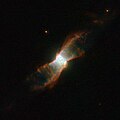Файл:NGC 6881 HST.jpg
NGC_6881_HST.jpg (532 × 532 кропак, аб’ём файла: 129 KB, тып MIME: image/jpeg)
Гісторыя файла
Націснуць на даце з часам, каб паказаць файл, якім ён тады быў.
| Дата і час | Драбніца | Памеры | Удзельнік | Тлумачэнне | |
|---|---|---|---|---|---|
| актуальн. | 12:13, 31 снежня 2019 |  | 532 × 532 (129 KB) | BevinKacon | actual size from source |
| 15:18, 12 сакавіка 2012 |  | 1 280 × 1 280 (266 KB) | Jmencisom |
Выкарыстанне файла
Наступная 1 старонка выкарыстоўвае гэты файл:
Глабальнае выкарыстанне файла
Гэты файл выкарыстоўваецца ў наступных вікі:
- Выкарыстанне ў ar.wikipedia.org
- Выкарыстанне ў az.wikipedia.org
- Выкарыстанне ў beta.wikiversity.org
- Выкарыстанне ў bs.wikipedia.org
- Выкарыстанне ў ce.wikipedia.org
- Выкарыстанне ў de.wikipedia.org
- Выкарыстанне ў diq.wikipedia.org
- Выкарыстанне ў en.wikipedia.org
- Выкарыстанне ў en.wikiversity.org
- Выкарыстанне ў eo.wikipedia.org
- Выкарыстанне ў eu.wikipedia.org
- Выкарыстанне ў fa.wikipedia.org
- Выкарыстанне ў fr.wikipedia.org
- Выкарыстанне ў hr.wikipedia.org
- Выкарыстанне ў kk.wikipedia.org
- Выкарыстанне ў lb.wikipedia.org
- Выкарыстанне ў mk.wikipedia.org
- Выкарыстанне ў my.wikipedia.org
- Выкарыстанне ў nl.wikipedia.org
- Выкарыстанне ў pl.wikipedia.org
- Выкарыстанне ў pt.wikipedia.org
- Выкарыстанне ў ru.wikipedia.org
- Выкарыстанне ў sk.wikipedia.org
- Выкарыстанне ў sr.wikipedia.org
- Выкарыстанне ў tr.wikipedia.org
- Выкарыстанне ў tt.wikipedia.org
- Выкарыстанне ў uk.wikipedia.org
- Выкарыстанне ў uz.wikipedia.org
- Выкарыстанне ў www.wikidata.org

